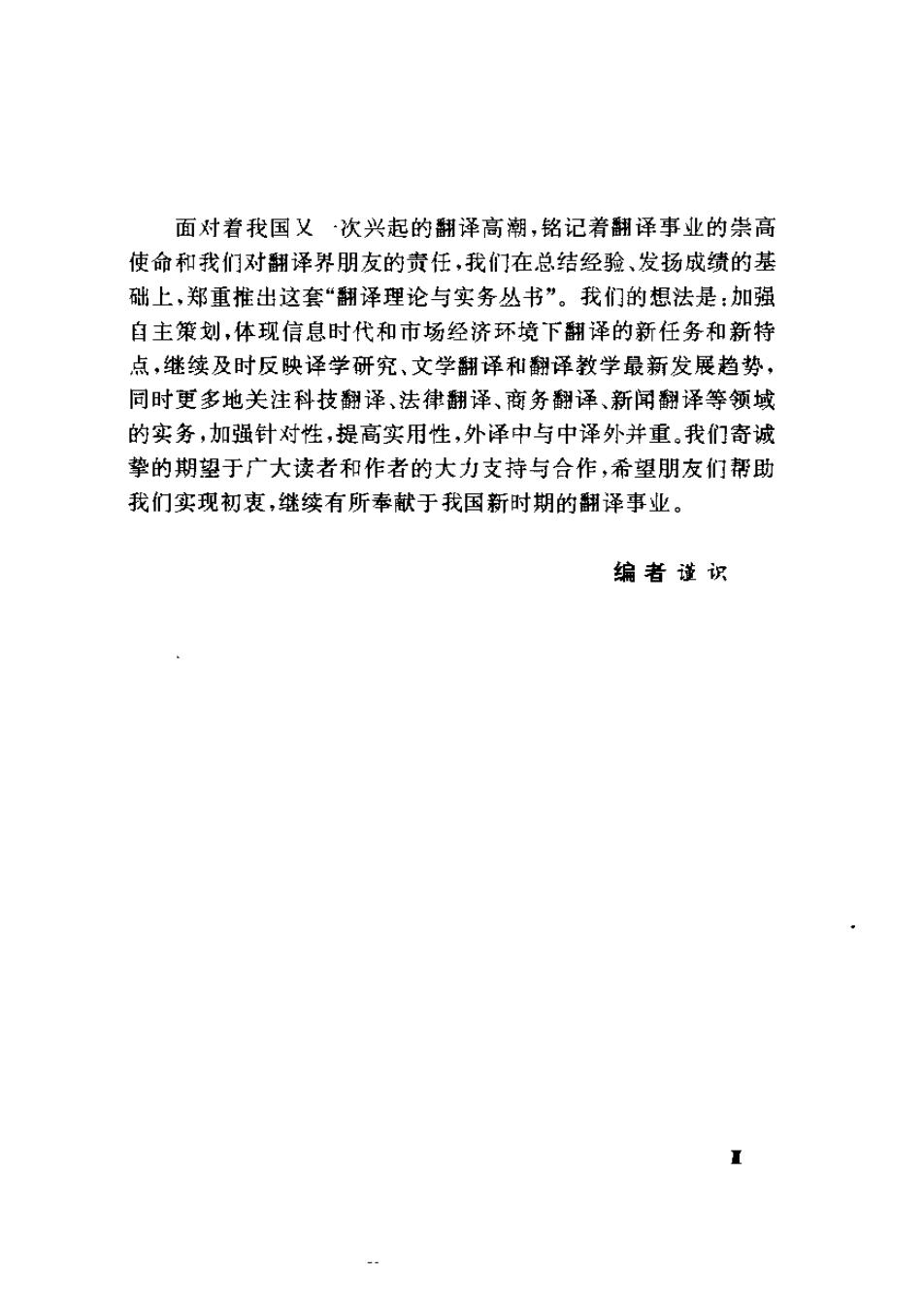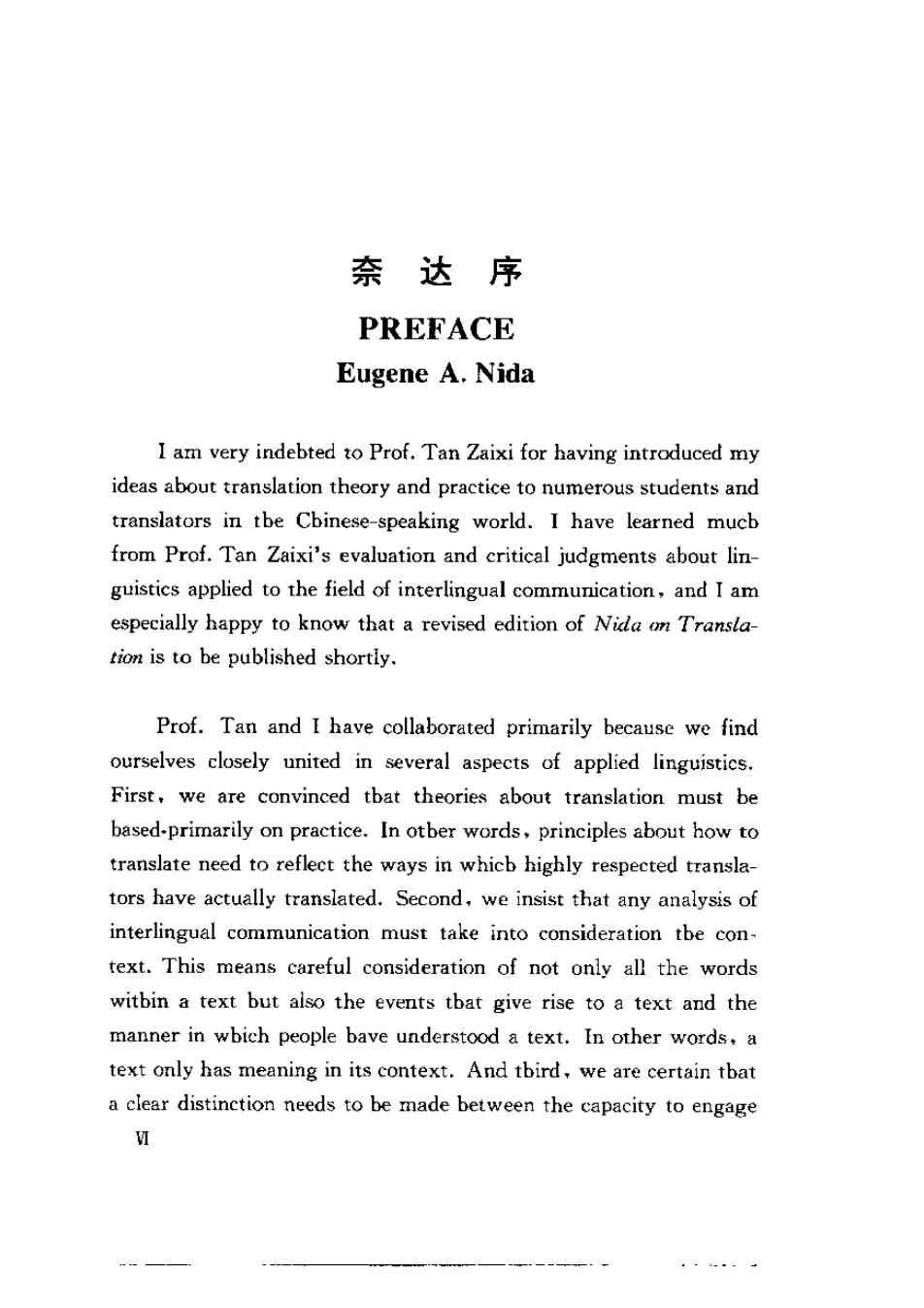
翻译,无论是作为文化现象、思想运动,还是作为一项职业、 种知识技能,总与所处的时代背景密不可分。翻译的观念、方法、样 式,标准、风格,无不与时俱进。观察一卜世界范围和中国国内的翻 译实践活动和理论研究,不难得出结论:翻译确实是人类精神文明 中最富活力、最敏锐的领域之·。信息时代和市场经济,决定了这 次翻译高潮最突出的持点。较之前一次翻泽高潮,这·次的翻译高 潮信息更庞大,涵盖面更广泛,题材体裁更丰富多样,操作方式 更灵活便捷,技术装备更先进,从业人员更众多,受益者更普遍,理 论研究更活跃,人才培训更具规模。从经济学观点看,翻译作为信 息产业之一支,现在所严生的经济效益也是历史上空前的。如果说 前三次翻译高潮,都是从外文译人中文为主,那么这一次翻泽高潮 则正在改变中国在翻译上的“人超”地位,介绍中国和了解中国的 迫切需要,对中译外提出了更高的要求。 认识到翻译对于丰富人类文化、促进文化交流,建设富强民主 文明国家中的重要作用,认识到翻译对于提高自身文化修养和专 业素质、保证职业生涯顺利成功方面的宝贵价值,现在越来越多的 青年人甚至少年人成了翻译的爱好者,他们要求学翻译、研究翻 译,有的立志投身翻译,他们需要高水屮的、切合实用的翻译研究 及学习读物,使学习和运用外语的水平更上一·层楼。 中国对外翻译出版公司,作为国内唯一以翻译为特色的国家 级出版机构,二十多年来陆续编辑出版数十种翻译理论与技巧类 图书,其中若干种已经成为翻译研究或教学领域脍炙人口的必读 书,在国内外翻译界赢得了声誉,也使我们深深感受到我们肩负着 翻译界老中青三代专家学者、教师、从业人员、学生和广大翻译爱 好者多么殷切的期望

面对着我国义·次兴起的翻译高潮,铭记着翻译事业的崇高 使命和我们对翻译界明友的贵任,我们在总结经验、发扬成绩的基 础上,郑重推出这套“翻译理论与实务丛书”。我们的想法是:加强 自主策刘,体现信息时代和市场经济环境下翻译的新任务和新特 点,继续及时反映译学研究、文学翻译和翻译教学最新发展趋势, 同时更多地关注科技翻译、法律翻译、商务翻译、新闻翻译等领域 的实务,加强针对性,提高实用性,外译中与中译外并重。我们寄诚 挚的期望于广大读者和作者的大力支持与合作,希望朋友们帮助 我们实现初衷,继续有所奉献于我国新时期的翻译事业。 编者谨识 夏

出版说明 《奈达论翻译》一书于1984年由中国对外翻译出版公司出版 后,在境内外读书界引起了较大反响。1985年冬,该书成为香港商 务印书馆门市部十大畅销书之-,并名列榜首。后来,介绍奈达新 著《从一种语言到另一种语言》的另一编译本《跨语交际》,义于 1993年由漓江出版社出版,同样受到广泛欢迎。二书均被境内外 多所高校的翻译系和外语院系用做译学教材及研究生参考读物。 由于《奈达论翻译》和《跨语交际》均早已脱销,为了满足境内 外广大读者和翻译专业学生的需要,现将二书内容加以综合,并根 据奈达本人建议,从其1996年出版的《跨语交际的社会符号学问 题》等最新研究成果中增加部分内容,出此新的版本。在新书的编 译过程中,仍然本着“洋为中用”、去粗存精的原则,对奈达的翻译 思想和理论进行综述,以理论介绍为主,略去不太适合我国读者的 部分,尽量采用原例说明。① ①由于奈达从事过《圣经翻译工作,故其命名多半选自《圣经英译本。我们从 探讨翻译技巧的角度选择了其中一部分,借以引证奈达的理论和观点。一编注。 N

奈达序 PREFACE Eugene A.Nida I am very indebted to Prof.Tan Zaixi for having introduced my ideas about translation theory and practice to numerous students and translators in tbe Cbinese-speaking world.I have learned mucb from Prof.Tan Zaixi's evaluation and critical judgments about lin- guistics applied to the field of interlingual communication,and I am especially happy to know that a revised edition of Nida on Transla- tion is to be published shortly. Prof.Tan and I have collaborated primarily because we find ourselves closely united in several aspects of applied linguistics. First,we are convinced tbat theories about translation must be based-primarily on practice.In otber words,principles about how to translate need to reflect the ways in whicb highly respected transla- tors have actually translated.Second,we insist that any analysis of interlingual communication must take into consideration tbe con- text.This means careful consideration of not only all the words witbin a text but also the events tbat give rise to a text and the manner in wbich people bave understood a text.In other words,a text only has meaning in its context.And tbird,we are certain tbat a clear distinction needs to be made between the capacity to engage I

in translating and the scientific study of the various linguistic and cultural factors involved in the translation process. We fully recognize that some of the most competent translators have never read a book about translation theory or practice.As pro- ficient multilinguals they have simply used their innate capacities for effective verhal communication to transfer both the content and the stylistic aestbetics of a text from one language to another.But we also recognize that many people with an effective knowledge of a foreign language and culture can also learn how to become compe- tent translators by studying how others have succeeded in what some scholars believe is perhaps the most complex event in human history-translating from one language to another. We also fully realize how urgent is the study of translating in a world in which we are only nanoseconds away from one another. Brussels,Belgium,8 February,1998. I